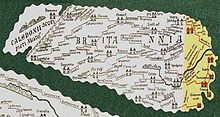
Sitomagus (also known as Sitomagum, Sitomago, and Senomagus) was a town in Roman Britain located in the province Flavia Caesariensis (now East Anglia) about 30 miles south of Venta Icenorum (now Caistor St Edmund) on the road to Londinium (now London) on route IX in the Antonine Itinerary, the location of which in Suffolk or Norfolk is uncertain.
The town has been associated with the Iceni. Proposed locations include Thetford, Ixworth, Stowmarket, Dunwich, Southwold, and Saxmundham.
The name "sito-" may derive from the Celtic for "wide" or "long", or "seno-" meaning "old", and "magus" meaning "market" or "plain". The version of the name as Senomagus appears in the Tabula Peutingeriana, an inaccurate 13th-century copy of a Roman map.
References
- ^ Steerwood, Robert (2003). "A context for Sitomagus: Romano-British settlement in the Suffolk mid-coastal area" (PDF). Proceedings of the Suffolk Institute of Archaeology and History. XL (3): 253–261.
- Knight, C. (1842). "SUF". The Penny Cyclopædia of the Society for the Diffusion of Useful Knowledge. Vol. 23. p. 220.
- ^ Haken, Mike (18 October 2017). "The Antonine Itinerary - Iter IX". The Roads of Roman Britain. Roman Roads Research Association.
- ^ Smith, LLD, William (1854). "Sitomagus". Dictionary of Greek and Roman Geography, illustrated by numerous engravings on wood. Walton and Maberly, Upper Gower Street and Ivy Lane, Paternoster Row; John Murray, Albemarle Street.
- Blomefield, Francis (1805). "Thetford, chapter 1: Of the name and Origin of the city". An Essay Towards A Topographical History of the County of Norfolk. Vol. 2. London. pp. 1–7. Retrieved 2 February 2021 – via British History Online.